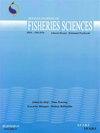Research Article: Development of a co-agglutination method for detection of Aeromonas hydrophila as causative agent of motile Aeromonas septicemia (MAS) disease in gourami (Osphronemus goramy)
IF 0.6
4区 农林科学
Q3 FISHERIES
引用次数: 0
Abstract
Aeromonas hydrophila is an opportunistic pathogen causing high mortality and economic burden in freshwater fish farming. This study aims to develop a co-agglutination method for detecting and creating Aeromonas hydrophila diagnostic rapidly. In this study, we injected rabbits (±2kg weight) with 1mL of A. hydrophila antigen suspension 1.2 x 109cfu mL–1 at one week intervals (three times, intra vena) respectively. The gouramis (15.48±0.55g-1 weight) were infected by Aeromonas hydrophila, Aeromonas sobria, Aeromonas salmonicida, Streptococcus agalactiae, and Pseudomonas aeruginosa separately with 0.1 mL fish–1 and 108 cfu mL–1 bacterial cell suspensions. The antiserum was purified to couple with the Staphylococcus aureus suspension protein A, in a 1:1 (v/v) ratio and used by the co-agglutination reagent. We compared this method with standard polymerase chain reaction(PCR) for A. hydrophila detection. The rabbit antibody reaction occurred only against A. hydrophila antigen showing specificity of the gourami tissue supernatant within 10-30 seconds. The sensitivity test had a detection limit of 106 cfu mL–1. Comparison detection method with PCR showed that positive result of A. hydrophila was located in 209 bp. Co-agglutination method could detect A. hydrophila in the internal organ of fish at 12h after injection, but the PCR method could detect at one hour after injection. This research concluded that co-agglutination method could detect A. hydrophila specifically, sensitively, rapidly and practically in laboratory and field examination.研究论文:用共凝集法检测食用鱼运动性败血症(MAS)致病菌嗜水气单胞菌的建立
嗜水气单胞菌是一种在淡水养殖中造成高死亡率和经济负担的机会性病原体。本研究旨在开发一种快速检测和创建嗜水气单胞菌诊断的共凝集方法。在本研究中,我们分别每隔一周(三次,静脉内)给兔子(±2kg体重)注射1mL嗜水气单胞菌抗原悬浮液1.2 x 109cfu mL–1。用0.1 mL鱼-1和108 cfu mL-1的细菌细胞悬浮液分别感染钩虫(15.48±0.55g-1重量)。将抗血清纯化以与金黄色葡萄球菌悬浮蛋白A以1:1(v/v)的比例偶联,并通过共凝集试剂使用。我们将该方法与标准聚合酶链式反应(PCR)检测嗜水气单胞菌进行了比较。兔抗体反应仅针对嗜水气单胞菌抗原发生,在10-30秒内显示出钩藤组织上清液的特异性。灵敏度试验的检测限为106 cfu mL–1。结果表明,嗜水气单胞菌的阳性位点为209bp。共凝集法可在注射后12h检测到鱼内脏中的嗜水气单胞菌,而聚合酶链式反应法在注射后1h检测到。本研究表明,共凝集法能在实验室和现场检测中特异、灵敏、快速、实用地检测嗜水气单胞菌。
本文章由计算机程序翻译,如有差异,请以英文原文为准。
求助全文
约1分钟内获得全文
求助全文
来源期刊

Iranian Journal of Fisheries Sciences
FISHERIES-
CiteScore
2.30
自引率
11.10%
发文量
0
审稿时长
3 months
期刊介绍:
1- Living various species (contains animals and vegetal species) in various aquatic ecosystems.
2- Health and diseases of aquatic species.
3- Determining the stocks and specific time and location for catching and reliable exploitation for sustainable development.
4- Methods of propagation and culture of high value aquatic resources.
5- Aquatic stock assessment and the methods of restocking the high value species and suggestion for rate, areas and the time for releasing fish and other aquatic organisms fries.
6- Pollutant agents and their effects to the environments of aquatic species.
7- Feed and feeding in aquatic organisms.
8- Fish processing and producing new products.
9- The economic and social aspects of fisheries.
 求助内容:
求助内容: 应助结果提醒方式:
应助结果提醒方式:


